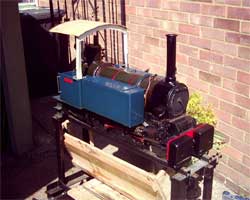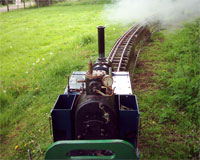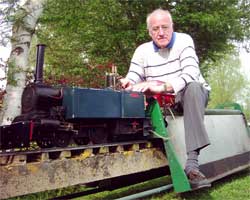
ORIGINS
Our association with the loco started entirely by chance during a family camping holiday in Norfolk in 1999. In the late 70's and 80's I used to be an avid reader of Model Engineer. However as the publication content changed to encompass a broader spectrum of clocks, machine tools and canons etc. and as my interest was mainly steam locomotives I stopped my subscription. I still, when away from home purchase the odd copy if available in a newsagent as I did on the holiday in question. Reading through the magazine in the evening I noted an advertisement for a 5" gauge tank locomotive for what seemed to be a very reasonable price. Thinking about it the following day I decided to enquire as to whether it had been sold. On contacting the owner I was surprised to find that he still had the locomotive, particularly as the magazine had been on the shelves for at least a fortnight. He proceeded to tell me that the loco was a freelance narrow gauge design of his own construction designed for Stephensons link inside frame valve gear but he had never completed the valve gear, merely connecting the forward eccentrics directly to the valves, so the engine would only run forwards. This had never troubled him as his local club track was a loop with no requirement to reverse. He stated that he had recieved only one other enquiry but the lack of valve gear seemed to put the prospective buyer off. An appointement was made to visit and view the loco some ten days hence, once we had returned from our holiday. On the September Saturday in question the asking price was withdrawn from the bank and course was set for London. On arrival the loco was sat on a bench in the garage and obviously had not moved for some time with rust on the frames paintwork faded and brightwork tarnished. It was an 040 wheel layout with outside cylinders, side tanks, round top copper boiler and cabless. First impressions were that it was well engineered but slightly "coarse" with socket head screws being used on cylinder mountings and covers and general appearance being practical rather than "fine scale". It's appearance was unconventional but strangely appealing. The boiler was copper, silver soldered but had no recent boiler test certificate, although the original certificate was available. Following a close inspection and considering the price reasonable, purchase was agreed. Then the problems started, the owner being elderly was unable to assist with moving the loco and it was far too heavy for my wife to assist. Luckily the owner had a transport trolley onto which I was able to move the loco and wheel it out to the car and then risking a slipped disc managed to lift it into the back of our 4x4. On arrival at home assistance was sought to move it into the workshop onto the bench where it quickly became apparent that to do any work on it a trolley would have to be constructed to assist with access. At the end of the weekend I was despatched abroad by my company to work on a ship in the United States so no further progress was made until December. On arrival home the priority was the construction of a box section steel "trolley" on which to store the loco and carry out maintenance. Once this was complete a thourough inspection was carried out and blanking plugs turned up for the boiler fittings so a pressure test could be carried out. The injector and pump clack valves were stripped and cleaned, pump packing checked and all fastenings and bushes checked for security and wear. The target to get it running was the new years day steam up on 1st January 2000. This was a close run thing with the hydraulic pressure test being completed on the morning prior to lighting up and carrying out the steam test and resetting the safety valves. All went well and on venturing out onto the track it proved a powerful loco, steaming well although suffering slightly from the common pitching motion of short wheel base locomotives. Not having a tender a plastic biscuit box had been adapted as a water tank to supply cold water to the injector and a discarded plastic ice cream container bolted on top to contain a supply of coal.
THE FUTURE
Since the first steaming in January 2000 very little work has been carried out, apart from a general clean and maintenance required to get it running the paint finish is largely untouched. The front buffer beam was removed and stripped and the buffer blocks (solid lead castings!") trimmed down slightly to improve the weight distribution, followed by repainting the beam and buffers prior to refitting. The lubricator output was reduced slightly as driver and passengers took on a speckled appearance from the excess output up the chimney and further routine boiler tests have been carried out but other than this the loco is essentially as purchased. It has been steamed @ 20 times over the past five years continuing to perform well.

The above picture shows the loco on it's transport trolley with a quick card mock up of a potential canopy fitted. It is intended when either time allows or a mechanical fault makes it neccesary, to carry out a complete overhaul of the loco. When operating the loco at ground level the backhead of the boiler is very close to the driving trolley making firing very awkward, so as for Dixie it is intended to construct a sympathetically designed 4 wheel tender. This will make firing easier and give a reliable cold water supply to the injector. It is also intended to fit a canopy along the lines of the mock up shown, adjust the springing and produce a new grate as the existing item is well worn. The boiler at present is unlagged which may explain the "green" paintwork (the previous owner being positive it was originally blue and has faded to green with the heat). At rebuild the opportunity may also be taken to clad the boiler although there is little clearance for this between the existing side tanks and the boiler shell. The loco can be seen in operation in the pictures below taken at our local club track.

